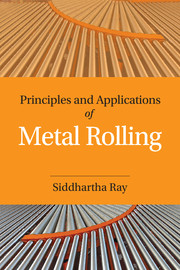3 - Rolling Practices
Published online by Cambridge University Press: 05 June 2016
Summary
In chapter 1, the process of rolling has been discussed along with the definitions and meaning of different terms used in the field of rolling technology. The different types of rolling stands that have evolved over time with their specific design features and uses have also been discussed.
In chapter 2, the mechanics of the rolling process has been discussed. Theoretical analysis of the rolling process in roll bite has been carried out to estimate the mean specific pressure necessary to be exerted on the metal in order to have the rolling with desired reduction possible. The role of the static yield stress of the metal and the effect of various other rolling conditions on this yield stress have also been discussed so that the actual rolling force involved can be worked out. Estimation of the rolling force along with torque and power necessary for rolling are the basic data for selection of the rolling stand to do a particular rolling operation.
In this chapter, the rolling practices generally followed by rollers have been discussed. For producing one or a group of finished rolled products (of different metals/alloys, shapes, sizes, quantities, etc.) the choice of mill stand design, its layout, rolling methods and techniques, pass sequence and schedule, etc., followed by a roller, is generally the meaning of the term rolling practice.
It is important to understand that the various rolling practices have been developed based on practical experiences of many rolling practitioners over ages. Still there exists a lot of variation between practices followed by different rollers and rolling plants. For producing same or similar product mix, different plants may be having different rolling equipment and / or different equipment layout. To suit the shape and size of the input materials and the type and layout of equipment, the plants are following different alternative rolling methods and pass schedules.
In this chapter effort has been made to explain some of the widely accepted practices for rolling of common products and provide background information on the principles and applications of roll pass design for the products.
- Type
- Chapter
- Information
- Principles and Applications of Metal Rolling , pp. 104 - 167Publisher: Cambridge University PressPrint publication year: 2016

